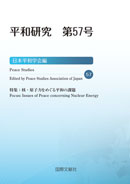Volume 57
Displaying 1-11 of 11 articles from this issue
- |<
- <
- 1
- >
- >|
-
2022Volume 57 Pages i-xi
Published: February 28, 2022
Released on J-STAGE: April 16, 2022
Download PDF (438K)
-
2021Volume 57 Pages 1-5
Published: 2021
Released on J-STAGE: January 31, 2022
Download PDF (272K)
-
2021Volume 57 Pages 7-29
Published: December 25, 2021
Released on J-STAGE: December 25, 2021
Download PDF (490K) -
2021Volume 57 Pages 31-55
Published: December 25, 2021
Released on J-STAGE: December 25, 2021
Download PDF (666K) -
2021Volume 57 Pages 57-79
Published: 2021
Released on J-STAGE: January 31, 2022
Download PDF (618K)
-
2021Volume 57 Pages 81-107
Published: 2021
Released on J-STAGE: January 31, 2022
Download PDF (3337K) -
2021Volume 57 Pages 109-135
Published: 2021
Released on J-STAGE: January 31, 2022
Download PDF (648K) -
2021Volume 57 Pages 137-165
Published: December 25, 2021
Released on J-STAGE: December 25, 2021
Download PDF (583K)
-
2021Volume 57 Pages 167-172
Published: December 25, 2021
Released on J-STAGE: December 25, 2021
Download PDF (333K) -
2021Volume 57 Pages 173-178
Published: December 25, 2021
Released on J-STAGE: December 25, 2021
Download PDF (336K)
-
2022Volume 57 Pages 196
Published: March 07, 2022
Released on J-STAGE: March 04, 2022
Download PDF (130K)
- |<
- <
- 1
- >
- >|
